Scottish Health Survey – telephone survey – August/September 2020: main report
Presents results for the Scottish Health Survey – telephone survey- August to September 2020, providing information on the health and factors relating to health of people living in Scotland.
This document is part of a collection
Chapter 3: Social Capital and Loneliness
Jessica Shields
This summary covers data collected between the 5th August 2020 and the 23rd September 2020.
Women were more likely than men to report that they contacted friends, relatives or neighbours* on ‘most days’.
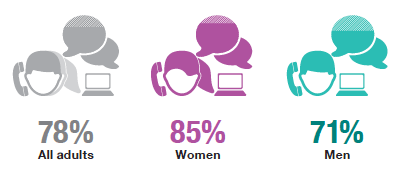
Adults in the youngest and oldest age groups were most likely to report contacting friends, relatives or neighbours* on ‘most days’.
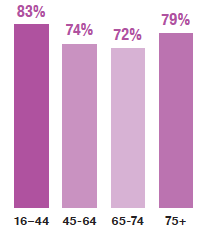
Half of adults reported they could turn to two to five people for support in a crisis.
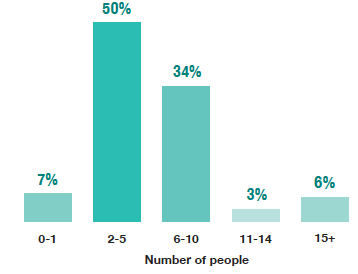
Men were more likely than women to report that they had no one or only one person to whom they could turn to for support in a crisis.
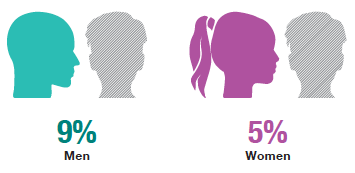
Almost a fifth (19%)** of adults reported that they felt lonely ‘some of the time’, ‘often’ or ‘all of the time’ in the last two weeks***.

Adults who had been advised to shield were more likely to report having felt lonely ‘some of the time’, ‘often’ or ‘all of the time’ in the past two weeks***.
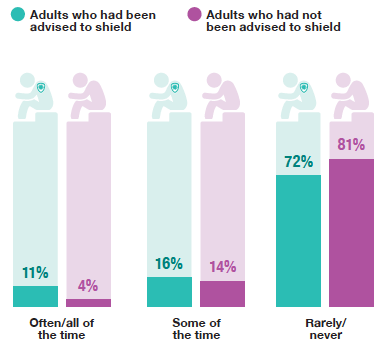
* In person, by phone, letter, email or through the internet.
** Due to rounding
*** Prior to being interviewed.
3 Social Capital and Loneliness
3.1 Introduction
Social capital is a term used to describe the social connections that provide support (social networks, workplaces etc.) and that are beneficial to the quality of life, health, safety, economy and wellbeing of individuals and the neighbourhoods in which they live. Such social connections promote a sense of individual and collective wellbeing as well as strengthening communities, offering a source of support and providing opportunities to meet others[1].
Loneliness and social isolation are increasingly recognised as significant public health matters[2] with the potential to impact significantly on mental wellbeing[3,4].
They can affect people of any age and in any circumstances, although key groups identified as being at increased risk include those with poor mental and/or physical health, those living in poverty, those with disabilities, those from LGBTI or minority ethnic communities and carers[5,6] and younger adults[7].
Before the COVID-19 pandemic, loneliness and social isolation were identified as priorities for the Scottish Government and in December 2018 A Connected Scotland[8] was published. This strategy sets out key priorities for tackling social isolation and loneliness and a roadmap for their collaborative implementation within communities. This accompanies both the Mental Health Strategy: 2017-2027[9] and Mental Health – Scotland’s Transition and Recovery[10] which aim to address problems with and support the mental health and wellbeing of the population of Scotland, of which social capital and loneliness are of direct relevance.
At the time of data collection for this survey, easing of restrictions around time outside of the home, social interactions and businesses that could open had been introduced, although some restrictions on the number of people that could meet were reintroduced during the fieldwork period[11].
This chapter examines social capital in relation to social contact and support networks and also loneliness among adults in Scotland in August and September 2020. Information on methods and definitions can be found in the Volume 2: Technical Report.
3.2 Social Capital and Loneliness
The fieldwork period referenced in the following analysis covers the period from the 5th August 2020 to the 23rd September 2020.
In interpreting these results, note that in this survey these questions were asked as part of the main interview. As questions on social capital and loneliness are potentially sensitive in nature, in the usual format of a Scottish Health Survey interview in the home they are included in a self-completion form which the participants complete themselves rather than the interviewer asking the questions. Self-completion formats may illicit a more accurate response from some participants who feel more comfortable answering sensitive questions privately. For this reason and as levels of loneliness tend to be higher in deprived areas where response to this survey was lower than usual, the following results may underestimate loneliness. See section 1.9.4 of the technical report for further details.
3.2.1 Social capital, August/September 2020, by age and sex
Over the fieldwork period, 78% of adults reported that they contacted[12] friends, relatives or neighbours ‘most days’ and a further 18% reported that they did so ‘once or twice a week’. Only 4% of adults reported that they had contacted friends, relatives or neighbours ‘once or twice a month or less (including never)’.
Women were more likely than men to report that they contacted friends, relatives or neighbours ‘most days’ (85% and 71% respectively), while men were more likely than women to contact friends, neighbours or relatives ‘once or twice a week’ (24% and 12% respectively). Adults in the youngest and oldest age groups were more likely to report having contacted others on ‘most days’ (83% among those 16-44 and 79% among those aged 75 and over) than those aged 45-74 (72% - 74%). There was no significant difference in the pattern by age for men and women.
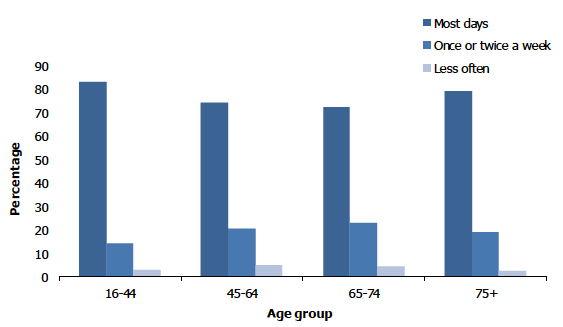
During the fieldwork period, 7% of adults reported they had no one or only one person to whom they could turn to in a crisis, this was higher among men than women (9% and 5% respectively). Half of adults (50%) reported that they could turn to two to five people in a crisis and a further 34% that they could turn to between six and ten people for support with 9% able to turn to 11 or more people. The number of people respondents felt they could turn to in a crisis did not differ significantly by age.
Figure 3A, Table 3.1
3.2.2 Social capital, August/September 2020, by whether received shielding letter/text and sex
On both measures, social capital did not differ among those who had received a shielding letter or text and those who had not. However, the proportion of women having no one or only one person to turn to for support in a crisis was higher among women who had received a shielding letter or text (11%) than those who had not (4%).
Table 3.2
1.6.3 Adult loneliness, August/September 2020, by age and sex
During the fieldwork period, 5% of adults felt that they were lonely ‘often’ or ‘all of the time’ and 15% reported that they felt lonely ‘some of the time’, while the majority of adults reported that they had ‘rarely’ or ‘never’ felt lonely in the two weeks prior to being interviewed (81%).
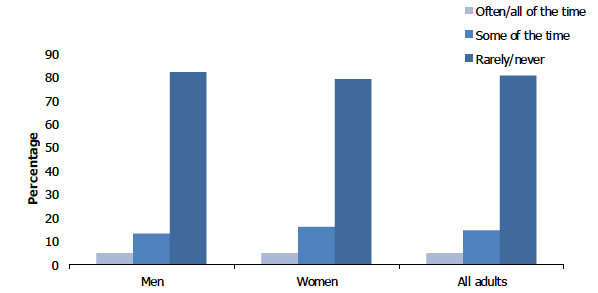
Reported experiences of loneliness in the two weeks prior to interview did not vary significantly by age or sex.
Figure 3B, Table 3.3
3.2.4 Adult loneliness, August/September 2020, by whether received shielding letter/text and sex
The frequency with which adults reported having felt lonely in the two weeks prior to being interviewed differed by whether they were advised to shield or not. Just over one in ten of those who had received a shielding letter or text reported that they felt lonely ‘often’ or ‘all of the time’ (11%), compared with less than one in twenty of those who had not received a shielding letter or text (4%). A reverse pattern was evident for the proportion in each group who reported having ‘rarely’ or ‘never’ felt lonely over the past two weeks, which was higher among those who had not received a shielding letter or text (81%) than among those who had (72%).
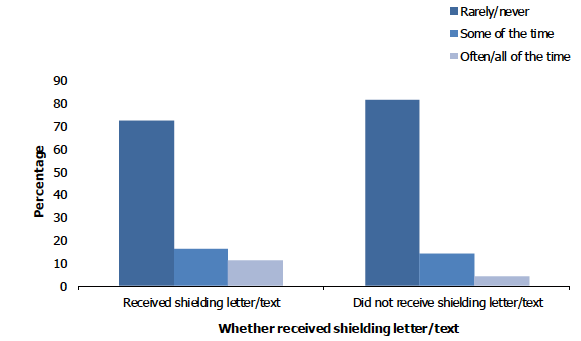
Similar patterns were evident for both men and women, with no significant differences by sex.
Figure 3C, Table 3.4
Table List
Table 3.1 Social capital, August/September 2020, by age and sex
Table 3.2 Social capital, August/September 2020, by whether received shielding letter/text and sex
Table 3.3 Adult loneliness, August/September 2020, by age and sex
Table 3.4 Adult loneliness, August/September 2020, by whether received shielding letter/text and sex
The tables can be found in the main report page under supporting documents.
References and notes
1. Social capital in Scotland: report. Edinburgh: Scottish Government (2020).
2. A Connected Scotland: our strategy for tackling social isolation and loneliness and building stronger social connections. Edinburgh: Scottish Government (2018).
3. Health Scotland (2018). Social Isolation and Loneliness in Scotland: a review of prevalence and trends. [online].
4. Christie, S and Wilson, V. (2019). Chapter 2: Mental Health and Wellbeing. In: McLean, J and Wilson, V. (eds.) The Scottish Health Survey 2019 – Volume 1: Main Report. Edinburgh: Scottish Government. 2020.
5. Health Scotland (2018). Social Isolation and Loneliness in Scotland: a review of prevalence and trends. [online].
6. Carers UK. (2019). Getting Carers Connected. London: Carers UK.
7. Christie, S and Wilson, V. (2019). Chapter 2: Mental Health and Wellbeing. In: McLean, J and Wilson, V. (eds.) The Scottish Health Survey 2019 – Volume 1: Main Report. Edinburgh: Scottish Government. 2020.
8. A Connected Scotland: our strategy for tackling social isolation and loneliness and building stronger social connections. Edinburgh: Scottish Government (2018).
9. Mental Health Strategy: 2017-2027. Edinburgh: Scottish Government (2017).
10. Mental Health – Scotland’s Transition and Recovery. Edinburgh: Scottish Government (2020).
11. Coronavirus (COVID-19): Scotland’s route map. Edinburgh: Scottish Government (2020).
12. This includes contact in person, by phone, letter, email or through the internet.
Contact
There is a problem
Thanks for your feedback